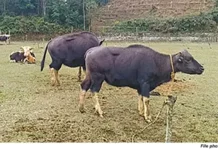NEW DELHI, 28 Nov: Jal Shakti Minister CR Paatil on Friday said building new dams is no longer a viable and long-term water management solution due to high costs, land acquisition hurdles, and shrinking river flows.
The minister urged states to align with the Centre’s push for conservation, and emphasised the need for collective action.
“We all know water gives life, but it also gives destruction when we fail to manage it,” Paatil said at the inauguration of the Ministry of Jal Shakti’s two-day summit on ‘Vision for Sujalam Bharat’.
He noted that while India has 18 percent of the world’s population and livestock, it has access to only 4 percent of global freshwater resources.
“We need water every moment, but we have not been able to organise it properly,” he said.
Highlighting the difficulties in constructing new dams, he said, “We have more than 6,500 dams, but we still store only about 750 bcm of water. It takes 25 years and Rs 25,000 crore to build a dam. Do we have that much time? Do we have that much money?”
Paatil further said that high cost, land acquisition hurdles, and shrinking river flows are key hurdles in pursuing a dam-based water storage strategy.
The government has shifted focus to large-scale water conservation, community participation, and groundwater recharge through the ‘Jal Sanchay Jan Bhagidari’ (JSJB) initiative and the Jal Shakti Abhiyan, he said.
The minister highlighted the “rapid expansion” of JSJB structures, crediting citizens for “translating the prime minister’s words into action.”
“In the first 10 months, against the target of 10 lakh structures, people built 27.5 lakh,” he said, adding that this year’s goal was one crore structures.
He also urged states to make full use of MGNREGA allocations earmarked for water conservation.
Paatil also cited examples from Gujarat and Rajasthan to illustrate the impact of community-led efforts. In Banaskantha, he said, NGO Vantara and local farmers helped build 30,000 recharge structures, reviving drying wells.
“Government alone cannot do this. Water is not just a state subject, but it is the responsibility of all of us,” Paatil said.
He called upon officers to “put their talent to national service,” adding that meaningful work, not postings or positions, is remembered.
“If you put your vision on the ground, you can do great work,” he said.
Minister of State for Jal Shakti Raj Bhushan Choudhary said India’s groundwater situation requires urgent and evidence-based interventions, with nearly 29 percent of assessed units falling into ‘over-exploited’ or ‘critical’ categories.
“These realities call for a cohesive, science-driven, and sustainable water management strategy,” he said, noting severe groundwater decline in states such as Punjab and Haryana.
He said conservation and artificial recharge are now central to India’s water-security framework, with initiatives like the Jal Shakti Abhiyan and the JSJB turning water stewardship into “a shared national responsibility.”
The ‘Catch the Rain’ campaign has delivered “extraordinary results,” he said, citing 1.94 crore water-related works since 2019 and the mobilisation of more than four crore youths.
Choudhary also highlighted the health gains from river rejuvenation efforts under Namami Gange. Improved Ganga water quality in Uttar Pradesh and Bihar, he said, has led to a measurable reduction in diarrhoea, dysentery and enteric fever.
“Water security is not only an environmental or economic issue. It is a matter of dignity, health and social equity,” he said.
Minister of State for Jal Shakti V Somanna said India must combine traditional knowledge with technological solutions to ensure long-term water security.
He said 82 percent of rural households now have tap water under the Jal Jeevan Mission, and six lakh villages have achieved the open defecation-free status under the Swachh Bharat Mission.
Grey water treatment had reached 91 percent of villages, guided by the “reduce, reuse, recycle” framework, Somanna said.
He pointed to Karnataka’s Narayanapura left bank cxanal SCADA system as an example of technology improving efficiency, and to the ancient stepwell at the Ayodhya temple as a reminder that traditional structures can offer sustainable models even in hard-rock areas.
“Sujalam means abundance,” Somanna said, adding, “Our challenge is to convert a limited resource into an abundant one.” (PTI)


